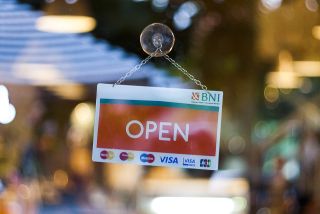Kids across the country this festive season are expecting deliveries to be made via sleigh and chimney, but it's 2020 and more likely the sleigh will take the form of a UPS or Amazon van. Consumers in the festive shopping rush are set to stuff stockings with online purchases in greater numbers than ever before, with recent research revealing people plan to spend an average of 64 percent of their holiday shopping budget online.
Why? The pandemic has seemingly accelerated a trend towards online shopping. However, that same survey revealed that 51 percent of respondents were anxious about shopping in-store this season, while also highlighting a boom in contactless shopping experiences with 73 percent of shoppers planning to have items delivered vs. 62 percent in 2019.
All signs point to the pandemic having an immediate effect on our shopping expectations for this season. But is this going to be a historical outlier, or are we looking at the new normal?
The truth is that retail was always trending towards contactless shopping – from self-service checkouts to same-day curbside delivery, we’ve looked at ways to keep contact to a minimum – and the pandemic has simply accelerated the trend. Yet one innovation promises to reshape the experience on the other side of the pandemic, merging a blend of contactless shopping with our love of browsing.
No cashier, no queues: Getting ready to grab and go
You may have heard about Amazon Go, Grab and Go and AiFi convenience and grocery stores, or possibly shopped at one. If not, in short: you fill up your grocery or shopping basket, and you just… walk out. No check-out line, no cashiers and certainly no entering a card into a machine and tapping in your PIN. It is, potentially, the ideal balance between minimizing contact and being able to browse in store freely and safely as in years gone by.
Each of these stores rely on Amazon’s “Just Walk Out” technology, which uses sensor fusion to track what a person purchases. In-ceiling cameras, shelf level sensing, real-time image recognition and deep learning to automatically add items picked up from a shelf to that person’s store app. From there, the customer can ‘just walk out’ without queuing, and have their accounts automatically charged the moment they leave the store. Those same technologies can also recognize when a product is removed from the customer’s physical shopping cart and returned to the shelf.
But that’s a lot of instant data transfer between the store and the cloud– we’re talking near-petabytes of data transfer on a daily basis, along with a need for close-to-instant compute and processing of that data to deliver a seamless experience to the customer.
So how is Amazon managing to do this so effectively?
Edge cloud on aisle five
Amazon has a dedicated server in or near the store, otherwise known as an Edge Cloud. In short, the Edge Cloud is a small cloud data center which is located as physically close to its customers or applications as is feasible in order to lower latency and deliver the compute and storage required to analyze petabytes of data in real time.
Edge Cloud data centers such as these are set to become the norm, with 5G rolling out across the planet to enable a more resilient, faster connection at those edges.
The move to cashier-less retail is certainly a trend on the rise. Take Amazon alone, which plans to open 3,000 Amazon Go stores in the US and has announced plans to sell the patented Just Walk Out technology to other retailers, and the scale of the Edge Cloud future becomes apparent. All told, the global edge data center market is expected to increase by more than $7 billion by 2024.
Yet it’s not as simple as just deploying thousands of mini clouds across the planet. To enable these applications to run seamlessly, the network of edge clouds needs to be architected in a way that it can be flexible and affordable in the long run. And there is a significant opportunity for service providers to host cloud edge applications like cashier-less retail.
Intelligence at the edge
These networks need to be adaptive and responsive and be able to readjust resources as needed to meet the demands of the application layer, and ensure they can manage, secure and automate the network end-to-end.
For example, if an outage occurs at one edge cloud datacenter, a service provider using an adaptive network can automatically shift connectivity to another edge cloud datacenter that meets the required latency of this application. If architected intelligently, the service provider network will be able to automatically adjust, allocate, and self-heal their distributed edge cloud resources using technologies such as SDN, NFV and open APIs.
Are people ready to return to in-store browsing if the key is minimizing the time spent queueing in crowds? Only time will tell, and when it comes to the festive rush, we may take even longer to become comfortable again with entering crowded stores. But that could buy network providers the requisite time needed to get the edge cloud network architecture in place.
Ultimately the cashier-less store is only as good as the seamlessness of the experience; if we enable a more programmable infrastructure that can adapt to support it, the way we shop in the festive seasons to come could be the ideal blend of contact free and in-store shopping that the festive season is all about.
Steve Alexander, CTO, Ciena
